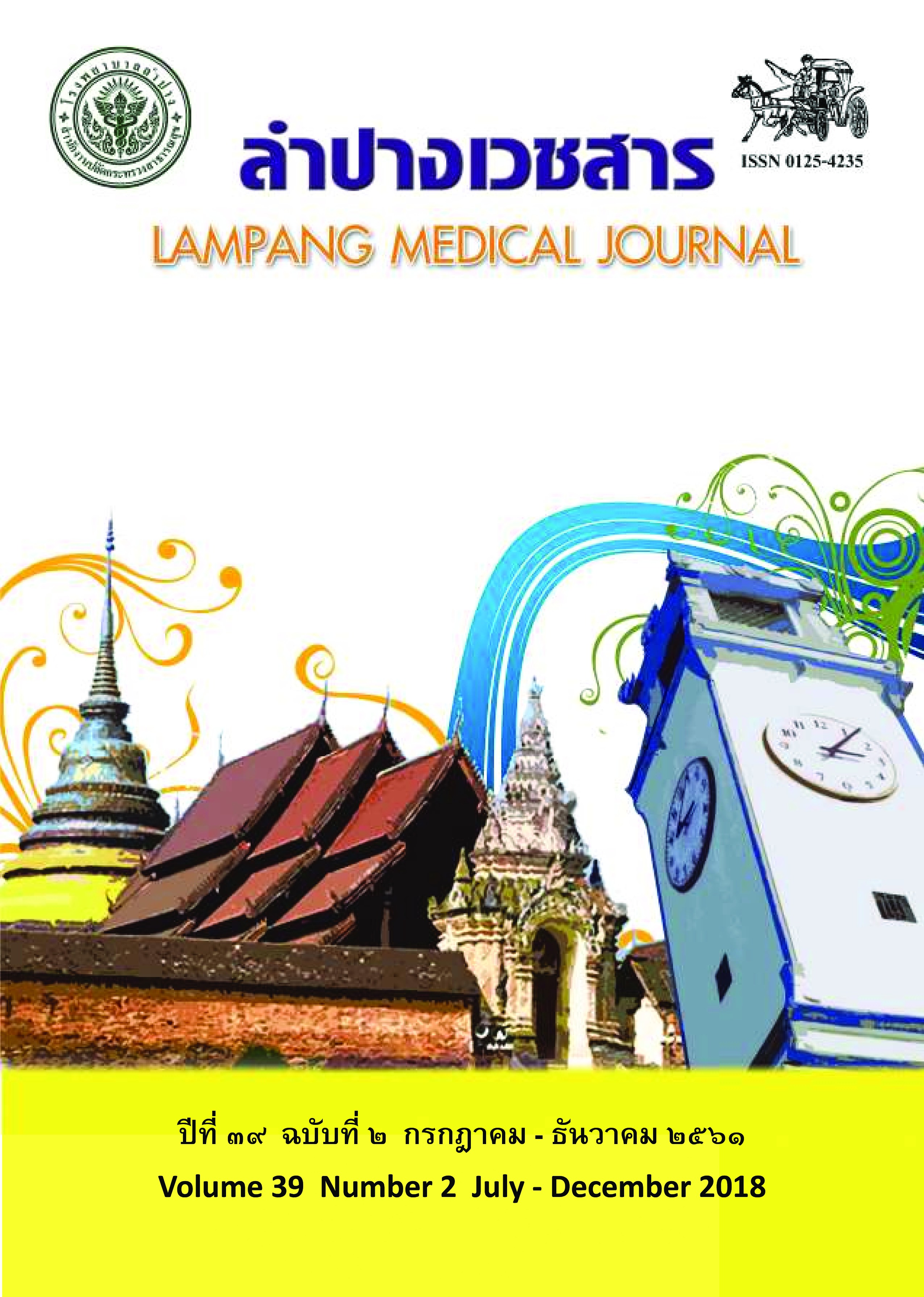Cost-outcome Analysis of Intensified Tuberculosis Case Finding Intervention among High Risk Population at Lampang Hospital
Main Article Content
Abstract
Background: Previous research has pointed out the high incidence of tuberculosis (TB) in the Thai population. Lampang Hospital has implemented an intensified TB case finding intervention for the high-risk population. However, there is, as yet, no information about costs and outcomes of such an intervention.
Objective: To evaluate the cost-outcome analysis of the intensified TB case finding intervention at Lampang Hospital. Material and method: Data recorded between October 2017 and April 2018 among 11,021 people at risk of TB were collected from the electronic medical records for retrospective cost-outcome analysis. The at-risk population was divided into seven groups: the elderly, migrant workers, HIV-positive patients, and
those with alcohol abuse, cancer, chronic diseases (COPD, DM, and CKD stage 4-5), and others. Direct medical costs (DMC) consisted of the costs for out-patient visits, laboratory tests and other investigations. Direct non-medical costs (DNMC) comprised the costs of travel, food, and productivity loss. Costs were
approximated from the societal and provider’s perspectives, with base year 2017.
Results: Among the high-risk population, 56.1% was female. The elderly (47.2%) make up the largest proportion of the high-risk patients, followed by the chronic-disease group (33.1%). The number of new TB cases was 35 (317 cases per 100,000 population). Total costs and cost per TB case detected from
the provider’s perspective were 912,071 Baht and 26,059 Baht respectively, while the societal costs were 3,359,746 Baht and 95,993 Baht respectively. DMC accounted for 27.2%, whereas DNMC accounted for 72.8%. Chest radiographs were the highest cost item among the screening processes. The lowest
cost-effectiveness ratio was found in the ‘others’ group, followed by the COPD, the elderly and migrant workers groups, respectively. Conclusion: The major financial burden of a TB screening program weighs down on the client side. Cost-effectiveness in the patients with COPD, the elderly and migrant workers were higher than in the others. There was an extremely high rate of loss to follow-up in almost all steps along the screening
process, which requires further action to resolve this problem.
Article Details
บทความที่ส่งมาลงพิมพ์ต้องไม่เคยพิมพ์หรือกำลังได้รับการพิจารณาตีพิมพ์ในวารสารอื่น เนื้อหาในบทความต้องเป็นผลงานของผู้นิพนธ์เอง ไม่ได้ลอกเลียนหรือตัดทอนจากบทความอื่น โดยไม่ได้รับอนุญาตหรือไม่ได้อ้างอิงอย่างเหมาะสม การแก้ไขหรือให้ข้อมูลเพิ่มเติมแก่กองบรรณาธิการ จะต้องเสร็จสิ้นเป็นที่เรียบร้อยก่อนจะได้รับพิจารณาตีพิมพ์ และบทความที่ตีพิมพ์แล้วเป็นสมบัติ ของลำปางเวชสาร
References
2. กระทรวงสาธารณสุข, กรมควบคุมโรค. แผนยุทธศาสตร์วัณโรคระดับชาติ พ.ศ. 2560-2564 [อินเทอร์เน็ต]. นนทบุรี: กระทรวงสาธารณสุข, ส?ำนักวัณโรค; 2560 [สืบค้นเมื่อวันที่ 13 พ.ค.2561]. จาก: https://www.tbthailand.org/download/Manual/หนังสือแผนยุทธศาสตร์วัณโรคระดับชาติ%20FINAL_new%20des.pdf
3. ส?ำนักงานพัฒนานโยบายสุขภาพระหว่างประเทศ. รายงานภาระโรคและการบาดเจ็บของประชากรไทย พ.ศ. 2556. นนทบุรี:เดอะกราฟิโกซิสเต็มส์; 2558.
4. World Health Organization. ICD-10 version: 2016 [Internet]. Geneva: World Health Organization; 2016 [cited 2017 May 12]. Available from: http://apps.who.int/classifications/icd10/browse/2016/en
5. Drummond MF, Sculpher MJ, Claxton K, Stoddart GL, Torrance GW. Methods for the economic evaluation of health care programmes. 4th ed. Croydon: Oxford university press; 2015.
6. Techakehakij W. Cost-outcome Analysis of hypertension treatment at the out-patient department: a comparison across public health insurance schemes. Journal of Health Science 2016;25(2):284-95.
7. Techakehakij W, Wongwichit P, Suksom T, Burapatthananon A, Yamkaew W, Pooltim K, et al. Direct non-medical cost for health care seekers at the out-patient department: a cross-sectional survey. Journal of Health Systems Research 2013;7(2):235-40.
8. Ministry of Commerce. Bureau of Trade and Economic Indices. Consumer price index CPI in Thailand [Internet]. 2016; [cited 2018 June 4]; Available from: http://www.price.moc.go.th/price/cpi/index_new_all.asp.
9. วิเชียร เทียนจารุวัฒนา, ถาวร สกุลพาณิชย์, ดิชพงศ์ พงศ์ภัทรชัย, ขวัญประชา เชียงไชยสกุลไทย,บรรณาธิการ. คู่มือการศึกษาต้นทุนสถานบริการ สำนักงานปลัดกระทรวงสาธารณสุข. นนทบุรี:สำนักงานปลัดกระทรวงสาธารณสุข, กลุ่มประกันสุขภาพ; 2554.
10. ประกาศคณะกรรมการว่าจ้าง เรื่อง อัตราค่าจ้างขั้นต?่ำ (ฉบับที่ 8), ราชกิจจานุเบกษา เล่มที่ 133 ตอนพิเศษ 284 ง. (ลงวันที่ 7 ธันวาคม 2559).
11. กรมควบคุมโรค, สำนักวัณโรค. แนวทางการควบคุมวัณโรคประเทศไทย พ.ศ. 2561 National tuberculosis control programme guidelines, Thailand, 2018. กรุงเทพฯ: อักษรกราฟฟิคแอนด์ดีไซน์, 2561.
10. Srisuwan P, Koopitakkajorn T, Kingkaew P, Youngkong S, Tantivess S, Teerawattananon Y. Population-based screening for tuberculosis in Thailand 2013. Journal of Health Systems Research 2013;7:433-9.
13. World Health Organization. Systematic screening for active tuberculosis: an operational guide [Internet]. Geneva: Switzerland; 2015. [Cited 2017 May 12] Available from: http://apps.who.int/iris/bitstream/handle/10665/181164/9789241549172_eng.pdf?sequence=1
14. Manakul S. The active pulmonary tuberculosis detection in high-risk groups; a comparison between acid fast bacilli staining and GeneXpert assay. J Med Tech Assoc Thailand 2016;44(2):5717-24.


